The Kalash - The White Tribe Of Pakistan
earthWatch REVIEW 2012: In the mountains of the Hindu Kush in Pakistan, six thousand or so people live who look and sound very different from their neighbours. They claim to have lived in the area for thousands of years and they look to all intents and purposes, European. (TINJAUAN earthWatch 2012: Kalash - Puak Putih Pakistan. Di pergunungan Hindu Kush di Pakistan, 6000 atau lebih orang hidup yang kelihatan dan kedengaran sangat berbeza daripada jiran-jiran mereka. Mereka mendakwa telah tinggal di kawasan itu selama beribu-ribu tahun dan mereka melihat semua maksud dan tujuan, Eropah).
Many of the Kalash are blond haired and blue eyed, somewhat of an anomaly in Pakistan! Some believe that that they are descendants of Alexander the Great’s army though their true ethnic origins are still unproven. (Ramai daripada Kalash berambut perang dan bermata biru, agak anomali di Pakistan! Sesetengah orang percaya bahawa mereka adalah keturunan tentera Alexander the Great walaupun asal - usul etnik mereka masih tidak terbukti).
They have a significantly different outlook on life from the Muslims surrounding them - they are polytheistic and have a completely different folklore (which has been compared to that of ancient Greece). (Mereka mempunyai pandangan yang berbeza dengan ketara pada hidup dari umat Islam yang mengelilingi mereka - mereka adalah politeisme dan mempunyai cerita dongeng yang berbeza (yang telah dibandingkan dgn Greece purba).
Images credit: Left: Flickr User Yodod, Right: Flickr User Saad Sarfraz Sheikh
DNA testing has not, however, produced any connection to Greek people. Yet although there is no genetic support for a Greek origin, the tests on the Kalash also showed no detectable East or South Asian lineages. (Ujian DNA tidak, bagaimanapun, menghasilkan apa-apa sambungan kepada orang Yunani. Namun, walaupun tidak ada sebarang sokongan genetik asal usul Yunani, ujian ke atas Kalash yang juga menunjukkan tidak dapat dikesan Timur atau keturunan Asia Selatan).
Images credit: Left: Flickr User Manalahmadkhan, Right: Flickr User Manalahmadkhan
Taking into account genetic drift, it was then thought that the Kalash blood line originated in Eastern Europe, the Middle East and the Caucasus. However, another series of tests suggested that perhaps the Kalash are in fact aboriginal to the area with only negligible contributions from external peoples. In other words, the jury is still out as to where they actually come from but it might well be exactly where they are right now. (Mengambil kira hanyut akaun genetik, kemudian berfikir bahawa garis Kalash darah bermula di Eropah Timur, Timur Tengah dan Caucasus. Walau bagaimanapun, 1 lagi siri ujian mencadangkan bahawa mungkin Kalash adalah sebenarnya orang asli kepada kawasan dengan sumbangan hanya diabaikan dari orang luar. Dalam erti kata lain, juri masih keluar di mana mereka sebenarnya datang dari tetapi ia mungkin tepat di mana mereka sekarang).
They live in Kalasha Desh - which translates as the three valleys of the Kalash - and that is the limit of their people’s range. There are only around five thousand speakers of the language, Kalasha, left which in terms of a language means that it is critically endangered. However, it is thought that the language probably never had more than a few tens of thousands of speakers at any one time. (Mereka tinggal di Kalasha Desh - yang diterjemahkan sebagai 3 lembah Kalash itu - dan itu adalah had pelbagai kaum mereka. Terdapat hanya kira-kira 5000 penutur bahasa, Kalasha, meninggalkan yang dari segi bahasa bermaksud bahawa ia menghadapi ancaman kepupusan. Walau bagaimanapun, ia difikirkan bahawa bahasa itu mungkin tidak pernah mempunyai lebih daripada 1 puluhan beberapa ribu penceramah pada satu-satu masa).
Images credit: Left: Flickr User Manalahmadkhan, Right: Flickr User Yodod
As their numbers are very small the culture of the people who surround them have had an impact. Many of the Kalash in two of the valleys have converted to Islam, probably around fifty percent. They still practice many of the traditional aspects of Kalash life though the non-converts call them ‘sheiks’. A third valley, known as Birir, still clings to the traditional way of Kalash life. (Sebagai bilangan mereka sangat kecil budaya orang-orang yang mengelilingi mereka telah meninggalkan impak. Ramai Kalash dalam 2 lembah-lembah telah memeluk agama Islam, mungkin sekitar 50 % peratus. Mereka masih mengamalkan banyak aspek tradisional kehidupan Kalash walaupun saudara bukan memanggil mereka 'sheiks'. Lembah ke-3, dikenali sebagai Birir, masih berpaut kepada cara tradisional kehidupan Kalash).
By some standards the Kalash are very poor and it is true that they are subsistence farmers. Kalash houses are typically made from Deodar trunk to an ancient design. They appear singly or stacked up against each other up vertiginous hillsides. (Oleh beberapa piawaian Kalash adalah sangat miskin dan ia adalah benar bahawa mereka adalah sara hidup petani. Rumah kalash biasanya dibuat dari batang Deodar untuk reka bentuk purba. Mereka muncul secara tunggal atau disusun terhadap satu sama lain sehingga pusing lereng bukit).
Yet even though the houses often look precarious, they are built on solid stone foundations. Many have inbuilt beehives, given the villagers access to honey close by. Life is, however, hard. Outbreaks of cholera still happen regularly in these remote villages. (Namun, walaupun rumah sering melihat tidak menentu, ia dibina di atas asas batu pepejal. Banyak mempunyai sarang lebah yang terbina, memandangkan penduduk kampung akses kepada madu berhampiran. Kehidupan adalah, bagaimanapun, keras. Wabak taun masih berlaku dengan kerap di kampung-kampung terpencil).
In stark contract to the culture of Pakistan, the Kalash do not separate the sexes or disapprove of contact between men and women of different families. However, there is the ‘bashelini’ - a house in the village where menstruating women are sent until they regain ‘purity’ and rituals must be performed before she can return to her husband. (Dalam kontrak sekali dengan budaya Pakistan, Kalash tidak memisahkan jantina atau mencela dan hubungan antara lelaki dan wanita keluarga yang berbeza. Walau bagaimanapun, terdapat 'bashelini' - sebuah rumah di kampung di mana wanita haid dihantar sehingga mereka mendapatkan semula 'kesucian' dan ritual mesti dilakukan sebelum dia boleh kembali kepada suaminya).
Images credit: Left: Flickr User Manalahmadkhan, Right: Flickr User Yodod
Elopement is regular in Kalash society and - strangely - it occurs often among married women. The woman herself will write to the prospective groom and offer her hand, informing the new man how much her previous husband paid for her. (Pelarian untuk kawin tetap di Kalash masyarakat dan - pelik - ia sering berlaku di kalangan wanita yang sudah berkahwin. Wanita itu sendiri akan menulis surat kepada bakal pengantin lelaki dan menawarkan tangannya, memberitahu lelaki baru berapa banyak suaminya yang dahulu itu dibayar untuknya).
The Kalash have, for however long they have been in the Hindu Kush, made their livelihood by herding goats and farming. Yet tourism does not play a major part in their lives with many urban Pakistanis making the journey from the big cities to meet their light coloured rustic neighbours. (Kalash punyai, walau bagaimana lama mereka telah berada di Hindu Kush, membuat kehidupan mereka dengan penggembala kambing dan pertanian. Namun pelancongan tidak memainkan peranan penting dalam kehidupan mereka dengan banyak bandar Pakistan membuat perjalanan dari bandar-bandar besar untuk memenuhi jiran desa berwarna cahaya mereka).
The Kalash are protected by the government of Pakistan but their future is uncertain - particularly if the religion declines into theocracy. There have been recent Taliban incursions and a Greek aid worker was kidnapped in 2009 (she was returned unharmed four months later after an outcry). However, their relative isolation may well ensure the Kalash survive. (Kalash yang dilindungi oleh kerajaan Pakistan tetapi masa depan mereka tidak pasti - terutamanya jika agama itu enggan ke dalam teokrasi. Telah ada serangan Taliban baru-baru ini dan seorang pekerja bantuan Yunani telah diculik pada tahun 2009 (dia telah dipulangkan tanpa luka 4 bulan kemudian selepas bantahan). Walau bagaimanapun, pengasingan relatif mereka mungkin memastikan Kalash yang hidup).








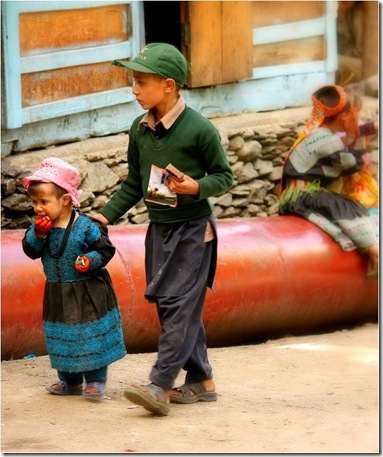
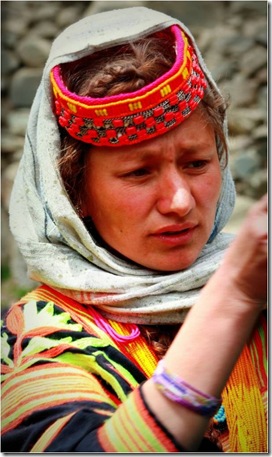


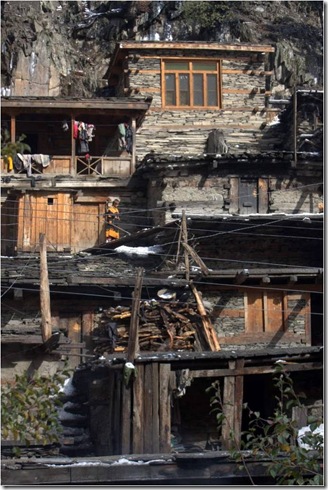

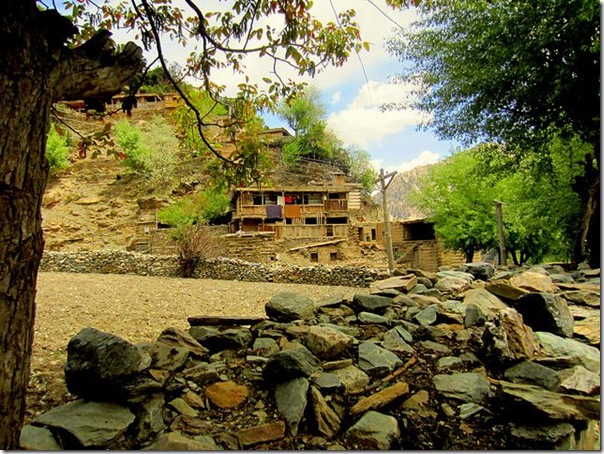



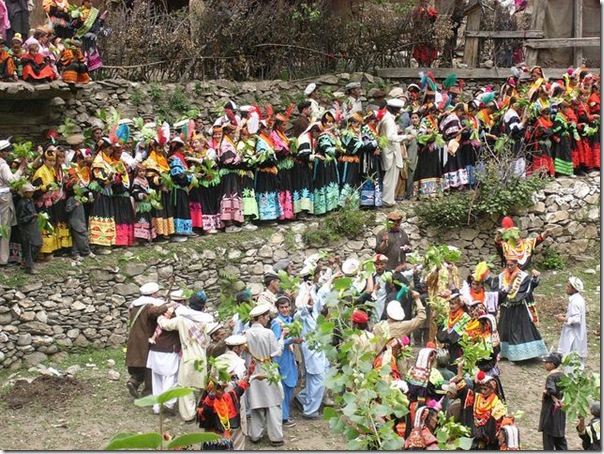


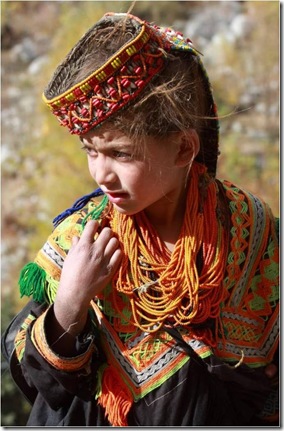
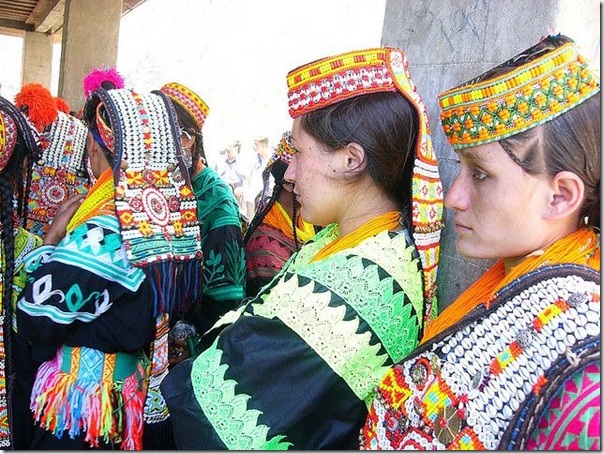



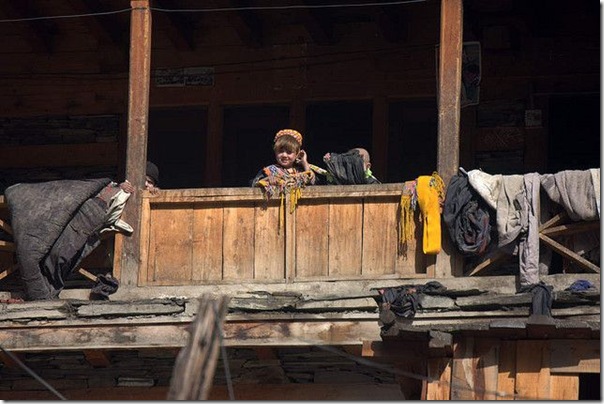
No comments:
Post a Comment